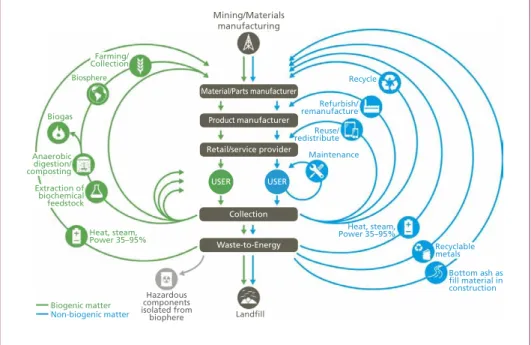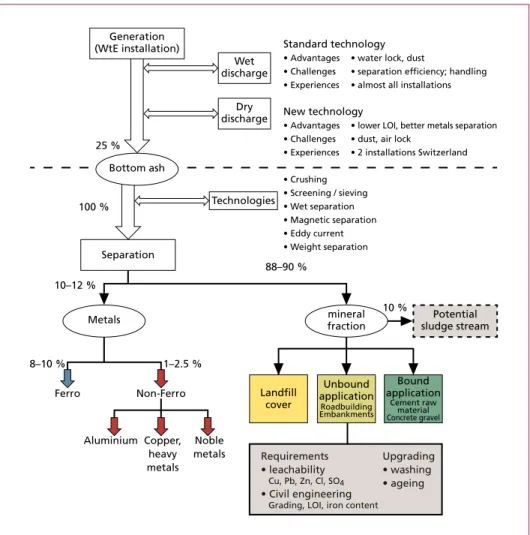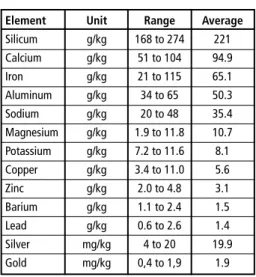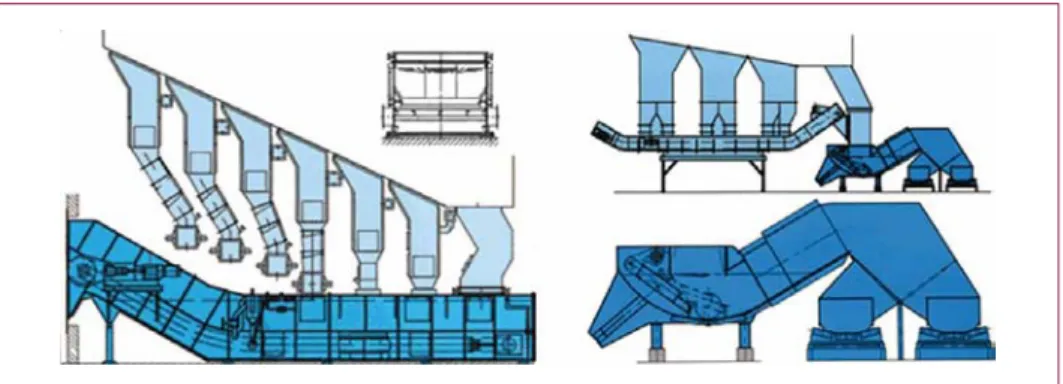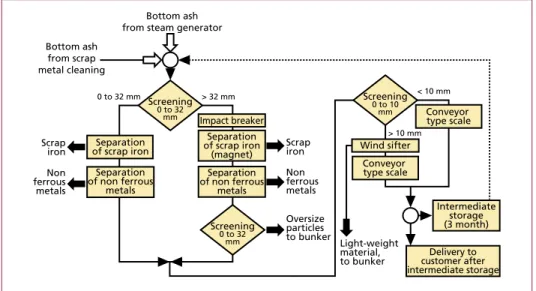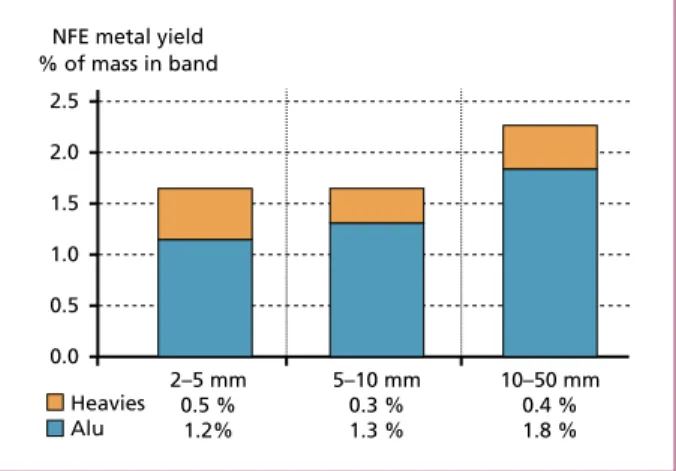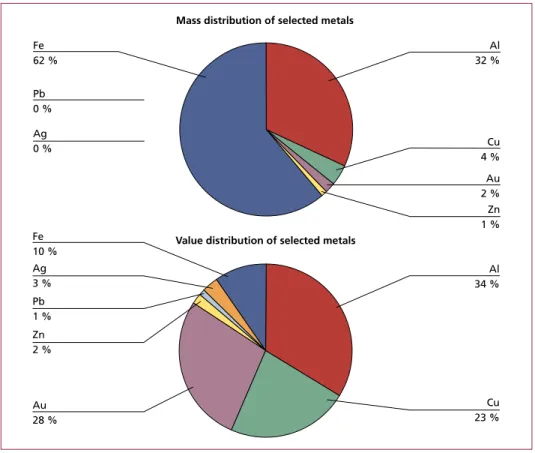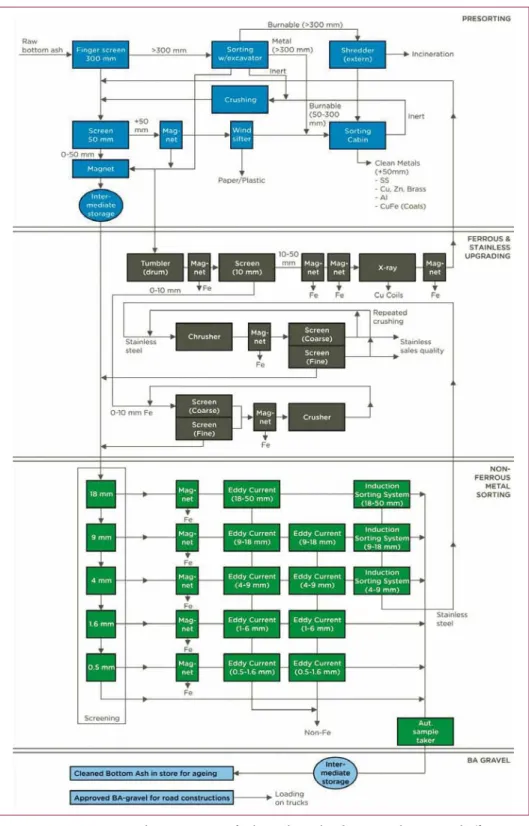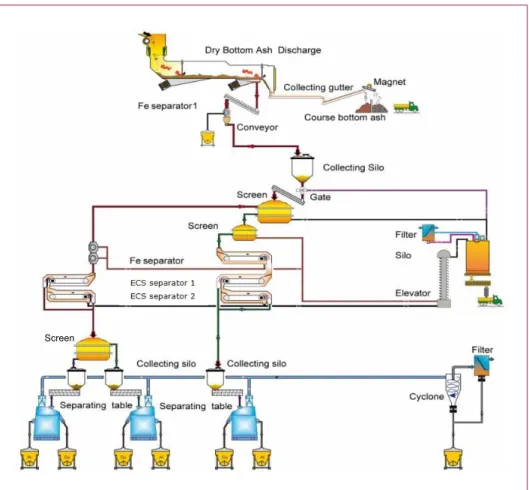Dorfstraße 51
D-16816 Nietwerder-Neuruppin
Tel. +49.3391-45.45-0 • Fax +49.3391-45.45-10
Order your book on www. .de
or contact us directly Mineralische Nebenprodukte und Abfälle
– Aschen, Schlacken, Stäube und Baurestmassen – ISBN: 978-3-944310-11-4 Published: 2014
Hardcover: 574 pages
with coloured images Price: 50.00 EUR
Mineralische Nebenprodukte und Abfälle 2 – Aschen, Schlacken, Stäube und Baurestmassen – ISBN: 978-3-944310-21-3 Published: 2015
Hardcover: 782 pages
with coloured images Price: 50.00 EUR
Editor: Karl J. Thomé-Kozmiensky • Verlag: TK Verlag Karl Thomé-Kozmiensky
M M
M M
M M
M M M
M M M
M M M
M
3 Karl J. Thomé-Kozmiensky
MINERALISCHE NEBENPRODUKTE UND ABFÄLLE 2
– Aschen, Schlacken, Stäube und Baurestmassen –
Karl J. Thomé-KozmienskyMineralische Nebenprodukte und Abfälle
2
Waste Incineration
Treatment of Bottom Ashes of Waste-to-Energy Installations
– State of the Art –
Frans Lamers
1. Introduction ...273
2. Overview ...273
3. Mass balance and composition of bottom ashes ...274
4. Metals and incineration ...275
5. Bottom ash discharge...277
5.1. Wet bottom ash discharge ...277
5.2. Dry bottom ash discharge ...278
6. Standard bottom ash treatment ...279
6.1. Screening and crushing ...280
6.2. Ferrous and non-ferrous metal separation ...280
6.3. Aging ...280
7. Developments in separation of ferrous and non-ferrous metals ...280
7.1. Metal distribution over grain size fractions ...281
7.2. Metal separation technologies ...283
8. Treatment of the mineral fraction...286
8.1. Civil engineering properties ...286
8.2. Environmental properties ...286
8.3. Aging ...287
8.4. Wet cleaning...288
9. Utilization of bottom ashes ...289
9.1. Road construction and embankment material ...289
9.2. Cement stabilization ...289
9.3. Concrete production...289
Waste Incineration
9.4. Cement clinker raw material ...289 10. Concluding remarks ...290 11. References ...290
Waste-to-Energy installations generate around 25 percent bottom ashes, that may be considered non-hazardous waste. On a total of 76 million tonnes of incinerated waste [4], this means a total of roughly 19 Million tonnes of bottom ashes. Separation of the bottom ashes in several fractions and recycling of the metals and stony fractions facilitate the further integration of Waste-to-Energy (WtE) technology as part of a circular econo- my. Recycling of metals and utilization of bottom ash will substitute the mining and manufacturing of virgin material, thus lowering the burden on our natural resources.
Mining/Materials manufacturing
Recycle
Refurbish/
remanufacture Reuse/
redistribute Maintenance
Heat, steam, Power 35–95%
Recyclable metals
Bottom ash as fill material in construction Material/Parts manufacturer
Retail/service provider Product manufacturer
Collection Waste-to-Energy
Landfill Hazardous
components isolated from biophere Heat, steam, Power 35–95%
Extraction of biochemical feedstock Anaerobic
digestion/
composting Biogas
Biosphere Farming/
Collection
Biogenic matter Non-biogenic matter
USER USER
Figure 1: Circular economy concept. When energy is recovered, bottom ash utilized and metals from bottom ash are recycled the material and energy is reintroduced into the economy.
Reintroduction of material and energy substitutes the consumption of natural resources.
The increased awareness on resource recovery potential in and of the bottom ash has caused substantial developments, such as more efficient separation techniques and alternative process solutions. The scope of this article is to give an overview of the current status of bottom ash treatment and the potential uses of the mineral and metal fractions.
Waste Incineration
1. Introduction
In European Waste-to-Energy installations, roughly 76 Million tonnes of municipal solid waste are combusted in more than 400 installations [4]. This is expected to increase further in the coming 10 years, dependent on financing and environmental licensing of new installations in UK and recent EU members. On average, municipal solid waste contains around 25 percent incombustibles/ashes, leading to roughly 19 million tonnes of ashes all over Europe.
The management, disposal or recovery of these ashes has a significant effect on the viability and the resource efficiency of Waste-to-Energy installations.
Whether or not the mineral fraction of the bottom ash is disposed or utilized varies in different countries. In some countries the mineral fraction has primarily been used as construction material in roads and embankments, whereas in other countries the mineral fractions of bottom ashes are landfilled. This is usually a result of legislation.
European Waste-to-Energy installations are mostly (95 percent) grate fired instal- lations, therefore in this paper the focus will be on bottom ashes from grate fired installations. The increased awareness on resource recovery potential in and of the bottom ash has caused substantial developments, such as more efficient separation techniques and alternative process solutions. The scope of this article is to give an overview of the current status of bottom ash treatment and the potential uses of the mineral and metal fractions.
This paper is largely based on the Authors own experiences and on the ISWA White papers Management of Bottom Ash from WtE plants – an overview of management options and treatment methods and Bottom Ash from WtE plants – metal recovery and utilization. Further literature references are explicitly quoted.
2. Overview
Figure 2 contains an overview of the aspects involved in generation and management of Waste-to-Energy bottom ashes: Generation of bottom ashes, bottom ash discharge (wet or dry), upgrading and developments in metals separation; utilization of the mineral fraction. Untreated bottom ashes may be considered as a waste material that needs to be landfilled if no measures are taken (shown in grey). However optimized management of bottom ashes will in the end lead to almost complete recycling, shown in green in the Figure 2. The exceptions on this are: use of the mineral fraction as landfill cover (yellow, cause debatable as utilization) and in case of wet separation for upgrading, the resulting sludge fraction still needs to be landfilled (dark gray). In this paper the separate aspects within bottom ash treatment, all focused on improvement of resource efficiency, are subsequently discussed.
Waste Incineration
3. Mass balance and composition of bottom ashes
The non-combustible fraction of the waste charged to the furnace forms a residue (ash) remaining on the grate at the completion of the combustion cycle. This material is generally referred to as bottom ash, but is also called grate ash, slag or clinkers.
The appearance of bottom ash is a mix of a very fine grey porous material with inert components such as fine gravel, rocks, glass and ceramics and metallic items.
Bottom ash consists of primarily Silicium, Calcium, Iron, Aluminum and Sodium.
Although the ash composition can be expected to vary from facility to facility, these elements are present within relatively predictable ranges. This is reflected in the results presented in table 1.
Generation (WtE installation)
Wet discharge
Dry discharge 25 %
100 %
88–90 % 10–12 %
1–2.5 % 8–10 %
Technologies
Separation
Metals mineral
fraction
Non-Ferro Ferro
Aluminium Copper, heavy metals
Noble metals
Landfill cover
Unbound application Roadbuilding Embankments
Bound application
Cement raw material Concrete gravel Standard technology
• Advantages • water lock, dust
• Challenges • separation efficiency; handling
• Experiences • almost all installations New technology
• Advantages • lower LOI, better metals separation
• Challenges • dust, air lock
• Experiences • 2 installations Switzerland
• Crushing
• Screening / sieving
• Wet separation
• Magnetic separation
• Eddy current
• Weight separation
10 % Potential sludge stream
Requirements
• leachability Cu, Pb, Zn, Cl, SO4
• Civil engineering Grading, LOI, iron content
Upgrading
• washing
• ageing Bottom ash
Figure 2: Overview of bottom ash treatment aspects
Waste Incineration
It is a common misconception that metals are of lesser value when they have gone through the Waste-to-Energy process. In fact, the exact opposite may sometimes be the case. For example, tin cans containing food leftovers, paper label and inside plas- tic coating will have to undergo multiple process steps of purification when sent for recycling. In the incineration process the plastic, paper and food will be completely removed. Thus incineration is an effective cleaning process that has a positive energy benefit and leaves clean metals in a concentrated form in the bottom ash
Many papers have investigated volatile metals behavior during the incineration pro- cess in view of their influence on human health. Mercury and Cadmium are the most important examples of volatile metals, that evaporate from the waste and concentrate in the fly ashes. Only in recent years more focus on the behavior of non volatile metals has developed. Examples of these metals which remain in the bottom ashes and which are suitable for recycling are iron, aluminum, copper, tin, zinc, lead, silver, gold and various alloys.
The main cause of losses of metals during incineration, is believed to be oxidation.
For oxidation to occur, it is required that the metals in the waste are in contact with oxygen. Modern WtE facilities carefully control the conditions at which the waste is The amounts of metallic items that can be separated from the bottom ashes vary, depending on the incoming waste composition. In literature, ferrous metals account for 7 to 15 percent of the bottom ash weight, whereas non-ferrous account for 1 to 2.5 percent of the bottom ash weight [2, 3, 12]. Such metals that appear in the bottom ash in metallic form are often removed from the bottom ash using various separation techniques. The high contents of non-ferrous metals can only be removed either from dry bottom ashes or through the use of advanced separation techniques.
4. Metals and incineration
The metals present in the bottom ash originate from the incoming waste com- position. During the incineration process, metals may evaporate, burn, oxidize or, as in most cases, remain on metallic form.
If the latter is the case, the metal can be recycled using current recycling practice.
Table 1: Approximate composition of bot- tom ash
Element Unit Range Average
Silicum g/kg 168 to 274 221
Calcium g/kg 51 to 104 94.9
Iron g/kg 21 to 115 65.1
Aluminum g/kg 34 to 65 50.3
Sodium g/kg 20 to 48 35.4
Magnesium g/kg 1.9 to 11.8 10.7 Potassium g/kg 7.2 to 11.6 8.1
Copper g/kg 3.4 to 11.0 5.6
Zinc g/kg 2.0 to 4.8 3.1
Barium g/kg 1.1 to 2.4 1.5
Lead g/kg 0.6 to 2.6 1.4
Silver mg/kg 4 to 20 19.9
Gold mg/kg 0,4 to 1,9 1.9
Sources: ISWA: Management of Bottom Ash from WTE Plants, 2006; averages based on (Astrup and Christensen, 2003).
Silver and gold values based on from results presented in Morf, L. S.; Gloor, R.; Haag, O.; Haupt, M.; Skutan, S.; Lo- renzo, F. D.; et al.: Precious metals and rare earth elements in municipal solid waste – Sources. Waste Management 33, pp. 634-644, 2013
Muchova, L.; Bakker, E. J.; Rem, P. C.: Precious metals in muncipal solid waste incineration bottom ash. Water, Air and Soil Pollution: an international journal of environmental pollution, pp. 107-116, 2009
Waste Incineration
incinerated i.e. controlling the supplied combustion air – oxygen availability – and waste layer thickness. By carefully controlling these parameters, it is ensured that the processes that occur in the actual waste layer are pyrolysis and gasification, whereas conversion gases are fully oxidized further in the flue gas channel, resulting in non- oxidizing conditions in the ash layer (pyrolysis occurs under absence of oxygen and gasification has understoichiometric oxygen conditions, so that the available oxygen will react with volatile matter prior to reacting with the metals.
Metals willingness to react, hydrolyze, oxidize, and change form is in basic chemistry ranked in a so-called reactivity series. The reactivity series for metals is shown in Fi- gure 3. The weakest base metals (K, Ca, Na) will react with water whereas other base metals will need to be in contact with acids. Only very strong acids will react with Ag, Au and Cu.
Base metals Noble metals
Fe Pb H Cu Ag
Hg
Au Zn
Al Mg
Na Ca K
+1,7V -2,9V
Figure 3: Reactivity series showing base and noble metals. Noble metals will only react with very strong acids. Base metals such as K, Ca and Na will react with water whereas Al and magnesium will react with acids, e.g. hydrochloric acid.
The reactivity series gives a good indication of which metals will be most affected by the incineration process. Another important factor is of course the respective metals boiling point. Mercury (Hg) has a boiling point of 357 ˚C, which is well below the temperature in the furnace. Consequently, the amount of mercury occurring in the bottom ash is negligible.
Figure 4:
Clean lump of aluminum after in- cineration. Embedded glass shard and complex shape means that melting occurred. Low degree of oxidation can be concluded due to the silvery and smooth surface.
Waste Incineration
Metals with a low melting point, such as Aluminum or Zinc, will experience melting and drip to the lower layers of the waste where it will again solidify as the temperature drops. Figure 4 shows a lump of aluminum from incineration. The lump has an em- bedded glass shard and a complex shape indicating melting. The lump is the size of a golf ball and shows low degree of oxidation. The metals in Figure 4 derive from a plant with dry bottom ash discharge, see section 5.2.
5. Bottom ash discharge
Two main types of bottom ash discharge systems exist – a wet and a dry. The two dis- charge systems are described below.
5.1. Wet bottom ash discharge
The wet bottom ash discharge is the most commonly installed bottom ash discharge system. Two main designs of removal exist, namely by a so called ram discharge or through chain transport. The main principle is the same. As the inert fraction reaches the end of the moving grate, it falls into a water bath. The quenching ensures that burning lumps are extinguished and cools the now wet bottom ash, thus.minimizing dust issues and making later handling easier. Furthermore, the water level can be set in an appropriate height ensuring an air tight seal from the surroundings to the furnace.
The bottom ash is mechanically removed as needed, either by a pressure piston (ram discharge) or by a chain transport system. Figure 5 shows a sketch of a wet bottom ash discharge system both with a chain transport system and with a ram system.
Figure 5: Principle sketch of the wet bottom ash discharge system with left a chain transport system and right a ram discharge system
The quenched bottom ash is either continuously transported through the chain system or batch wise through the ram discharge system and onto conveyor belts leading to a bottom ash bunker/silo. The water level can be set to ensure that there is an air tight seal. The main advantages of the wet system are the air lock through the quench and the effective prevention of dusting. However the wet extraction has a number of dis- advantages: agglomeration of grains making the ashes sticky and making it more difficult
Waste Incineration
to separate metals; quenching the ashes during the process may lead to more unburned particles (LOI); transport and management of the ashes will be more expensive due to added weight of moist.
5.2. Dry bottom ash discharge
A new development is the dry discharge of bottom ashes. Dry bottom ash discharge was the predominant slag extraction until the 1990’s, but where replaced by wet systems due to a number of undesired effects, namely dustproblems, risk of fires and loss of air tightness in the installation, requiring additional ventilator power. In recent years dry discharge has been re-developed, mitigating the aforementioned negative aspects and focusing on a number of positive aspects. Because of the bottom ash discharge without the use of water, the metals are neither quenched nor introduced into an alkaline envi- ronment. Furthermore, the mineral fraction of the bottom ash will not lump together, making later separation of metals and mineral fraction easier.
Two modern dry slag extraction systems are now in operation. Both of them are located in Switzerland and have different designs.
The SATOM plant in Monthey, Switzerland, has converted a wet discharge system (ram type) as depicted in Figure 5.
The conversion means running the discharge system without water addition. As the bottom ash leaves the discharger it enters a wind sieve. The wind sieve operates through a vibrating conveyor, where the bottom ash falls across different levels with suction in the opposite direction of the movement. The coarse bottom ash is removed by conveyor belts and the remaining fraction is sent for further sorting. The air suction through the wind sieve separates the light airborne fraction of the bottom ash. The suction is caused by the secondary combustion air fan. The dust is subsequently separated from the air stream using a cyclone, prior to being used as secondary combustion air. As part of the secondary combustion air is drawn through the wind sieve, the air is preheated by the warm bottom ash.
Secundary combustion
air
Air intake
Cyclone Dust Furnace
Air intake Coarse bottom ash Bottom ash
discharge Windsieve
Figure 6:
Bottom ash discharge system with wind sieve installed
Another dry bottom ash discharge system is installed at the KEZO plant in Hinwill, Switzerland. This discharge system consists of a vibrating conveyor where the bottom ash is cooled by so-called tertiary air. The tertiary air is limited by vertical gates and driven by a slight vacuum in the furnace. The flow of tertiary air is approximately 500 Nm3/ton waste. At the end of the vibrating conveyor the bottom ash is fractioned
Waste Incineration
by a perforated floor, thus separating the bottom ash into fraction above and below 5 mm. The vibrating conveyor is shown in Figure 7. The fraction below 5 mm is frac- tioned at the end of the vibrating table and sent for further sorting.
Storage silo Fe-seperator
Extraction OL2
Water
Tertiary air Tertiary air
6. Standard bottom ash treatment
In countries that focus on the utilization of bottom ashes, standard treatment of MSWI bottom ash has since around 15 years constituted of the following steps: screening, metal recovery and aging to ensure decrease of organics and low leaching of critical components. Such processing can constitute of the treatment steps shown in Figure 8.
Figure 7:
Dry bottom ash discharge sys- tem installed at the KEZO plant in Hinwill
Bottom ash from steam generator Bottom ash
from scrap metal cleaning
0 to 32 mm > 32 mm
Impact breaker Separation of scrap iron
(magnet) Separation of non ferrous
metals Separation
of scrap iron Separation of non ferrous
metals
Screening 0 to 32
mm
Screening 0 to 32
mm
Scrap iron Nonferrous metals
Oversize particles to bunker Scrap
iron ferrousNon metals
Screening 0 to 10
mm
< 10 mm Conveyor type scale
Conveyor type scale Wind sifter
Intermediate storage (3 month)
Delivery to customer after intermediate storage Light-weight
material, to bunker
> 10 mm
Figure 8: Typical bottom ash processing; different screening mesh sizes are used in different countries
Waste Incineration
6.1. Screening and crushing
Screening is carried out with standard drum or flat deck screens with a 45 to 50 mm mesh size resulting in a gravel type sand with an improved compaction performance without any further measures. In construction works an optimum compaction is es- sential to ensure that the aggregate does not settle after construction.
Crushing may be undertaken to reduce the particle size to make the ash suitable for some applications, such as in cement and concrete. However, crushing is not usually carried out because screening alone can provide the necessary grain size fractions for road construction applications without the expense associated with crushing.
6.2. Ferrous and non-ferrous metal separation
Ferrous and non-ferrous metals are separated from the bottom ashes through the use of magnets and eddy current separators, to a minimum size of 8 to 10 mm. The reco- vered metals are recycled through the international scrap market. Non-ferrous metals separation improvements have primarily been induced by the increased appreciation of the added value of recycling of the non-ferro metals, both as a consequence of the strong increases in non-ferro prices (and thus economic viability) and as a consequence of a better understanding of the value of bottom ashes as a non-ferro ore. The envi- ronmental aspects of ferrous and non-ferrous metals separation are almost negligible.
However, removal of the metals does improve the mechanical properties of the bottom ash making it more suitable for use for construction purposes.
6.3. Aging
MSWI bottom ash is exposed to the atmosphere to allow organics to decompose and metal oxides and hydrates to react with water and carbon dioxide to form carbonate.
These reactions reduce the leachability of the metals and reduce the potential impact on the environment.
Aging is normally achieved by leaving the ash in a stockpile to allow rainfall and time to complete the reactions. For the new generation of incinerators an aging time of at least 3 to 4 months is required.
7. Developments in separation of ferrous and non-ferrous metals
Important developments in the separation of ferrous and non-ferrous metals are to be found in the minimum grain sizes that can be separated. Whereas in the conventional bottom ash treatment, minimum grain sizes are 8 to 10 mm, in further developed schemes, minimum grain sizes below 1 mm can be found, thus substantially increasing ferrous and non-ferrous yields.
Waste Incineration
7.1. Metal distribution over grain size fractions
Figure 9 shows the non-ferrous metals presence in different size fractions. It can be seen that the total contents of non-ferrous metal yields in a the 2 to 50 mm fraction is substantially higher than the non-ferrous contents in the fraction 10 to 50 mm The recovered metal types are generally found in all fractions. In terms of mass, iron comprises most of the metal present in bottom ash followed by especially aluminum.
In terms of value, however, precious metals present in small quantities are of high economic importance.
2.5 2.0 1.5 1.0 0.5
NFE metal yield
% of mass in band
2–5 mm 0.5 %
1.2%
5–10 mm 0.3 % 1.3 %
10–50 mm 0.4 % 1.8 % 0.0
Heavies Alu
Figure 9:
Non-ferrous metal yields in diffe- rent size fractions. The fractions are subdivided into aluminum and heavies (Cu, Au, Ag, Zn etc.).
Table 2: Amount of selected metals present in bottom ash. Scrap prices are subject to variation and thus appro- ximate values.
Metal Amount Estimated scrap kg/ton price (EUR/kg)
Fe 31.4 0.12
Al 16.1 0.80
Cu 2.2 4.00
Zn 0.9 0.73
Pb 0.3 1.07
Ag 0.004 270
Au 0.0004 27600
Source: Morf, L. S.; Gloor, R.; Haag, O.; Haupt, M.; Skutan, S.;
Lorenzo, F. D.; et al.: Precious metals and rare earth elements in municipal solid waste – Sources. Waste Management 33, pp. 634-644, 2013
In a study performed at the KEZO plant in Switzerland, it was found that more than 31 kg of iron could be found per tonne of pre-treated bottom ash whereas the gold content was about 0.4 grams per tonne [9].
Even though iron content comprises most of the recoverable metals, the economic value of the iron is roughly 10 percent of the total metal value, whereas the small amount of gold comprises almost 30 percent of the total metal value.The amounts of some selected metals found in the before mentioned study, as well as the approximate scrap value of each selected metal, is listed in table 2.
Figure 10 shows the mass and value distri- bution of selected metals, based on metal content found in the bottom ash of the KEZO WtE facility.
Waste Incineration
Metals from WtE plant with wet bottom ash discharge will be coated with a thin layer of solidified mineral material (Oxides of Silicon and Calcium). This coating will not appear on slag from dry bottom ash. The difference is shown in Figure 11.
The mineral layer on metals from wet bottom ash can be removed using acid. However, according to experience gained at the SCANMETALS upgrading plant in Denmark, this process step is not necessary, as the value of metals does not increase if cleaned prior to re-melting.
Figure 10: Mass and value distribution of the metal present in bottom ash, based amount and values presented in Table 2
Figure 11: Difference between metals sorted from a wet and dry bottom ash; the mineral layer on metals from wet bottom ash can be easily removed
wet bottom ash dry bottom ash
Al 32 %
Ag
0 % Cu
4 % Au 2 % Pb
0 % Fe 62 %
Zn 1 %
Al 34 %
Au 28 %
Cu 23 % Zn
2 % Fe 10 %
Pb 1 % Ag 3 %
Mass distribution of selected metals
Value distribution of selected metals
Waste Incineration
7.2. Metal separation technologies
As can be concluded from the foregoing paragraph, the main developments in metal separation are focusing on lowering the minimum grain size from which metals can be removed. A number of options to come to this effect are described subsequently.
Wet separation system using serial screening down to 0.5 mm
Figure 12 shows a wet separation system to be realized in 2015 by AFATEK in Copenha- gen, Denmark. The bottom ash has a residence time of 1 to 2 months prior to separation.
The system is designed to handle bottom ash with a water content of 10 to 15 percent.
If water content is controlled, separation efficiency of metals can run up to 90 percent.
AFATEK has reported that monitoring water content is of importance, as it affects the downstream process performance. Bottom ash with a low water content is easier to separate than a very wet bottom ash. Additional care must be taken regarding dust handling with these relatively dry bottom ashes.
The process flow diagram in Figure 12 shows the flow of bottom ash throughout the screening and separation facility. The raw bottom ash enters the facility and, at first, undergoes pre-sorting. In pre-sorting, bulky and oversized objects (> 300 mm) are removed from the stream and manually sorted. The bottom stream ash is then screened at 50 mm. The bottom ash in the 50 to 300 mm interval undergoes magnetic sorting, x-ray sorting and some degree of crushing, in order to liberate metals embedded in larger chunks of solidified mineral material.
The main development is that the fraction below 50 mm undergoes progressive screening into the fractions 18-50, 9-18, 4-9, 1.6-4 and 0.5-1.6 mm. For each of these intervals, iron is removed using a magnet, non-ferrous metals are removed with an ECS and stainless steel is removed using an ISS separator.
Wet system using serial screening down to 2 mm and so-called ADR
The Dutch company INASHCO has in collaboration with the Delft University of Technology (TU Delft) developed a separation technique, in which ballistic separation is used to separate the fine, soft and light minerals with the hard and heavy metals/
rocks. The installation is called ADR – Advanced dry recovery – and is focused at the fraction 0-2 mm. The Inashco installation works most efficiently in combination with classification of the bottom ashes in several fractions down to 2 mm and non ferro separation from these fractions with conventional Eddy current technology.
In the ADR the bottom ash stream fall onto a turning bladed drum. As the bottom ash is struck by the drum blades, the different components of the bottom ash – mineral fraction, rocks and metals – will obtain different ballistic paths. Furthermore, the different ballistic paths are assisted by a downward blowing jet stream. The light components – mineral fraction – will fall down to the first conveyor belt exiting the apparatus. The heavy components – rocks and metals – will experience a more flat ballistic curve and therefore land on the second conveyor belt.
Waste Incineration
Figure 12: AFATEKs modern wet sorting facility to be realized in 2015; the expected efficiency is 90 percent
Waste Incineration
The air jet separation is repeated to increase purity of the separated stream. The fine, light and soft components and the hard and heavy components will thus be separated.
The INASHCO Company is progressively closing contracts with European WtE instal- lations to operate their metal separation technique and reaches high sorting efficiencies that are however not disclosed systematically.
Separation of dry bottom ashes
Figure 13 shows the sorting system installed at the ZAR sorting facility, treating fine bottom ash from the KEZO plant, which have a modern dry extraction system installed.
The coarse bottom ash, larger than 5 mm, is wetted and treated externally, similarly to the process described in section 6.1.
Magnetic iron is first separated from the discharged bottom ash (< 5 mm) before tem- porary storage in a collecting silo. The purpose of the storage silo is to act as a buffer in the system.
Figure 13: Sorting system at ZAR treating dry bottom ash from the KEZO plant; the course bottom ash (>5 mm) is wetted and handled externally
Screen
Waste Incineration
The bottom ash < 5 mm is first sieved in an enclosed vibrating screen into the frac- tions 0.7-5 mm and 0.2-0.7 mm. The 0.7-5 mm fraction first undergoes removal of fine magnetic iron by use of a magnet. The removed iron is disposed of along with the bottom ash. After removal of the magnetic iron, the stream undergoes two steps of ECS separation for removal of non-ferrous metals. The mineral fraction of the bottom ash is led to a silo. The stream of non-ferrous metals, separated by the ECS, is further divided into 0.7-3 mm and 3-5 mm fractions using a sieve. Each of these two streams are fed into separating tables, which are able to separate the non-ferrous metal into aluminum and a mixture of other non-ferrous metals (primarily Cu and some Zn, Au, Ag etc.). The separation tables separate the metals based on their density.
The 0.2 to 0.7 mm fraction separated in the first sieving undergoes a secondary sieving.
This is done to ensure a precise cut, making subsequent metal extraction more efficient.
The stream undergoes one step of magnetic separation and two stages of ECS prior to separation into aluminum and a mixture of other non-ferrous metals. The mineral fraction is, after the ECS separation led to the same silo as the 0.7 mm fraction. The sorting system is fully enclosed and kept in a slight vacuum, ensuring that the working environment is virtually dust free.
8. Treatment of the mineral fraction
After removal of metals, the mineral fractions of the bottom ash can be either landfilled or utilized for construction purposes, if the material complies with the regulatory re- quirements. As a construction material, bottom ash has especially been used as a sub base material in road construction, substituting virgin gravel material. Other forms of utilization can be used in low-tensile strength concrete products, decreasing demand for energy intensive concrete production.
This section presents some uses, process steps for use and some environmental con- siderations.
8.1. Civil engineering properties
The civil engineering properties of bottom ash have been thoroughly studied in seve- ral countries. Generally speaking, the quality of the bottom ash as a road foundation material or as an embankment material is high, making the ash suitable as a substitute for sand and gravel as a sub-base material.
8.2. Environmental properties
MSW Bottom ashes do show leaching that is relatively high for Cu, Cl, SO4, Pb and some other metals. The impact of that leachability on the utilization is dependent on the regulatory framework per country. Some countries have determined that bottom ashes should be landfilled (Switzerland, also Sweden). In a number of countries, the leaching behavior in civil engineering applications is controlled by using bottom ashes
Waste Incineration
that are compliant with relatively benign leaching demands (separating good quality bottom ashes from lesser quality ashes) only under a cover (clay liner) and by long term monitoring of water quality around the construction (Germany, Denmark, France, also Netherlands). Still, one of the challenges of utilization in sedimentary environments is that ashes need to be encased to prevent leaching of heavy metals to the groundwater and that long term monitoring is often required.
In the Netherlands therefore the Government and the Waste-to-Energy sector agreed on further cleaning of bottom ashes in a so-called Green Deal, both focusing on optimizing metal recovery and minimization of leachability. To accomplish that further cleaning of bottom ashes by wet processes or the use of bottom ash in concrete is planned for the coming years.
8.3. Aging
Aging is a relatively simple treatment done prior to or after metal separation. Aging is the combination of CO2 uptake from the atmosphere and chemical reactions following contact with water. Contact with water due to the wet slag extraction or wetting after dry slag extraction.
Proper Aging can effectively be achieved by storing the bottom ashes with good access to air, water and occasional turning. Figure 14 shows stockpiles of bottom ash during aging.
Figure 14: Examples of stockpiles of bottom ash for open air weathering
By ensuring aging is done prior to utilization or landfilling, the reactivity of the bottom ash and the leaching of metals are reduced. This is due to:
• Mineralogical and geochemical changes due to uptake of CO2 (carbonation) and thereby lowering of pH (typical from pH 11-12 to pH 8-10)
• Hydration and other changes in the mineral phases in the bottom ash
• Binding/sorption of dissolved elements – especially heavy metals – to the matrix of the bottom ash
Waste Incineration
• Removal or transformation of available organic ligands, e.g. by evaporation, leaching, or changes in the binding characteristics
• Leaching of highly dissolvable salts
Research has shown, that the concentration of various components in leachate follows the pH value of the leachate [15]. Copper leachability is strongly related to Dissolved organic carbon [14], Leachate collected during weathering has a high concentration of highly soluble salts and minor amounts of metals. Primarily copper chlorides and sulphates. Typically, the bottom ashes are aging until the chemical reaction with water goes from strongly alkaline to somewhat neutral. It takes 6 to 20 weeks of weathering before the ash is chemically stable and suitable for utilization or landfilling [1, 5].
Besides improving the leaching properties of the bottom ash, weathering improves the mechanical properties as the bottom ash becomes chemically stable.
In the Netherlands tests have been performed with enhanced aging (in a container, controlling CO2 and air addition. In spite of the fact that this enhanced aging indeed reduces leaching effectively, this approach is not further pursued because aging in itself does not reduce leachability to the stricter leaching level agreed between government and Waste-to-Energy sector.
8.4. Wet cleaning
Wet cleaning of MSWI bottom ashes is primarily required if the leaching level of bottom ashes needs to be reduced substantially, specifically for chlorine and sulphate on one hand and some of the leachable metals on the other hand. In the Netherlands several companies are developing wet cleaning technology, combined with advanced fractioning.
The Belgian company Indaver has installed a wet treatment process, where the extracted bottom ash is washed in a special washer barrel prior to metal separation. A simplified diagram of the process is shown in Figure 15.
Figure 15: Simplified process diagram of Indavers washing process
Wet bottom
ash discharge Sieve, 50 mm To metal recovery
Washer barrel
Light organic material to furnace To metal recovery
< 50 mm
Waste Incineration
Bottom ash smaller than 50 mm is washed in excess water from the flue gas cleaning process. Light organic material released from the washing process is reintroduced to the furnace.
Metals within the bottom ash are removed after the washing process using standard metal separation technology, as described in Chapter 6. The purpose of the washing process step is to reduce trace element content and subsequent leaching during landfil- ling/utilization. In the indaver process, the bottom ash below 2 mm does not undergo metal separation. Consequently, in the Indaver case the metal content in this fraction is currently not recovered.
9. Utilization of bottom ashes 9.1. Road construction and embankment material
France, Germany, Denmark and the Netherlands are examples of European countries that utilize bottom ash from waste incineration as a sub base material for road con- struction and for road embankments/noise barriers. In all countries, the degree of contamination of the leachate is tested prior to utilization. The limits for utilization and test method vary by country, because of which a comparison is not possible. However, the degree of utilization is high in all cases.
9.2. Cement stabilization
In Switzerland bottom ash is generally landfilled and thus not utilized. However, the finer fraction of bottom ashes is in some cases utilized in fly ash stabilization. In fly ash stabilization, cement and water is mixed with the fly ash, creating a solid chemically inert concrete block. By mixing the fine fraction of the bottom ash with the fly ash, less cement must be added in order for the mixture to solidify and stabilize the fly ash.
The demand for virgin produced cement is thereby lowered.
9.3. Concrete production
Unreinforced concrete products with low tensile strength can also be produced using bottom ashes. Dutch Waste-to-Energy installations are strongly focusing on the market for concrete aggregates to develop utilization of the bottom ashes with a low environmental impact.
9.4. Cement clinker raw material
In Italy specific fine fractions of the bottom ash are utilized as an additive to the cement clinker raw materials.
Waste Incineration
10. Concluding remarks
Bottom ash as such can be an excellent building material that shows an acceptable en- vironmental impact. Furthermore, making use of bottom ash shows resource savings in virgin materials and fossil fuels. Metal separation improves environmental and me- chanical properties of bottom ash and is of increasing economic importance. Regardless if the bottom ash is landfilled or utilized, metal sorting should always be carried out.
Substantial developments have taken place regarding the metals separation from bottom ashes, thus increasing non ferro removal from around 0,8 to 1 percent in the past up to 2.5 percent in upgraded facilities.
Metal separation by eddy current methods is a method that is straightforward. In view of the high non ferro prices on the world market, investments into installations have a very short pay back period.
11. References
[1] Astrup, T.; Christensen, T. H.: Slagge fra affaldsbehandling – Status og udviklingsmuligheder år 2003. Miljø & Ressourcer DTU
[2] Baun, D.; Kamuk, B.; Avanzi, P.: Treatment of bottom ash from Waste to Energy plants: overview and experiences. Sardinia Eleventh International Waste Managament and Landfill Symposium.
Cagliari, Italy, 2007
[3] Born, J.: Green Deal. Presentation to VGB, 18 November 2014
[4] CEWEP website (2015) data on waste to energy in Europe, 2011 and 2012
[5] Hjelmar, O.; Holm, P. E.; Lehmann, N. K.; Asmussen, O.; Rose, N.: Grundlag for nyttiggørelse af forurenet jord og restprodukter, Miljøprojekt, nr. 415. Miljøstyrelsen, 1998
[6] ISWA: Management of Bottom Ash from WTE Plants, 2006
[7] ISWA: Bottom Ash from WtE plants – metal recovery and utilization, 2015 (in preparation) [8] Kallesøe, J.: Recovery of resources in bottom ash, 2012
[9] Morf, L. S.; Gloor, R.; Haag, O.; Haupt, M.; Skutan, S.; Lorenzo, F. D.; et al.: Precious metals and rare earth elements in municipal solid waste – Sources. Waste Management 33, pp. 634-644, 2013
[10] Muchova, L.; Bakker, E. J.; Rem, P. C.: Precious metals in muncipal solid waste incineration bottom ash. Water, Air and Soil Pollution: an international journal of environmental pollution, pp. 107-116, 2009
[11] Muchova, L.: Wet separation of bottom ash. PHD Thesis Delft University of Technology, 2010 [12] Sabbas, T.; Polettini, R.; Astrup, T.; Hjelmar, O.; Mostbauer, P.; Cappai, G.; et al.: Management
of municipal solid waste incineration residues. Waste Management, pp. 61-88, 2003
[13] Stiftung Zentrum Für Nachhaltige Abfall- Und Ressourcennutzung (ZAR): Annual Report, 2011 [14] van Zomeren, A.; Comans, R. N.: Contribution of natural organic matter to copper leaching.
Environmental Science & Technology 38, pp. 3927-3932, 2004
[15] Zhang, H.; He, P.-J.; Shao, L.-M.; Li, X.-J.: Leaching behavior of heavy metals from municipal solid waste incineration bottom ash and its geochemical modeling. J Mater Cycles Waste Manag 10, pp. 7-13, 2008
Dorfstraße 51 D-16816 Nietwerder-Neuruppin
Download free
articles on www. .de
34
0 1 1 2 3 3 18
28 33 37 39 41 44 51 54 57 63 65 73 75 77 79 79 82 84 85 87
99
0 2 50 24
35 42 52 49 35
52 36
33 34
17 16 20 16 2
20 20 10 9 0 1 10 0 1 0 0 0
50 57
7 42
65 57 47 50 62
45 47 39 34 46 45 38 40
47 27 24 27 26 27 25
13 21 21 18 16 16 13
1
50 40 42
0 10 20 30 40 50 60 70 80 90 100 percentage
%
Recycled and composted Incinerated Landfilled
HOW DO I FIND RELEVANT ARTICLES?
Alternative 1: Search by topic
If you are looking for articles regarding a specific topic, please go to “kostenfreie Artikel” (i.e. free articles, in the top right corner of our homepage). Take a look on the left-hand side. Here you find a complete list of the general terms in alphabetical order. Most of them are further divided into sub-themes. Just click on your topic of interest, and you will find the available relevant articles with their bibliographical data. In order to open and download the article, click on the articles title.
Alternative 2: Search by conference
If you are looking for articles regarding a specific conference/congress or book, please go to “Fachbücher” (i.e. reference books, in the top right corner of our homepage). Take a look on the left-hand side. Here you find a list of the themes, which are covered by our publications. Choose your field of interest. You will then see all relevant books listed in the order of their release date, starting with the latest publication. Once you find the right book, follow the link “Inhaltsverzeichnis” (i.e. table of content). In order to open and download an article published in the book, click on the articles title.
Alternative 3: Search by author
If you are looking for articles from a specific author, please go to the search field “Suchen…” (in the top right corner of our homepage). Enter the name of the author and you get a list of relevant results. Free, downloadable articles can be recognized by the [PDF] mark (on the left-hand side).
The database is still being worked on.
If you have problems finding your article, please contact us.
In case you are interested in more than one article of the same book, you might as well just order the book from us.
waste generation • waste incineration • flue gas treatment • balancing and evaluation • bio waste • biogas • biomass • soil steam generator • dismantling • landfill • emission trading • pyrolysis • solid recovered fuels • district heating, district cooling, process steam • odour • sewage sludge • corrosion and materials • logistics • mechanical-biological treatment • mechanical treatment • mineral by-products and wastes • co-incineration • electricity grids • photovoltaic • physical-chemical treatment • planning • legislation • recycling • residues • solar thermal energy • energy storage • drying • turbine and generator • underground storage and backfilling of mines • fan and stack • gasification • wind power • profitability
Bibliografische Information der Deutschen Nationalbibliothek Die Deutsche Nationalbibliothek verzeichnet diese Publikation in der Deutschen Nationalbibliografie; detaillierte bibliografische Daten sind im Internet über http://dnb.dnb.de abrufbar
Thomé-Kozmiensky, K. J.; Thiel, S. (Eds.): Waste Management, Volume 5 – Waste-to-Energy –
ISBN 978-3-944310-22-0 TK Verlag Karl Thomé-Kozmiensky
Copyright: Professor Dr.-Ing. habil. Dr. h. c. Karl J. Thomé-Kozmiensky All rights reserved
Publisher: TK Verlag Karl Thomé-Kozmiensky • Neuruppin 2015
Editorial office: Professor Dr.-Ing. habil. Dr. h. c. Karl J. Thomé-Kozmiensky, Dr.-Ing. Stephanie Thiel, M. Sc. Elisabeth Thomé-Kozmiensky.
Layout: Sandra Peters, Ginette Teske, Janin Burbott-Seidel, Claudia Naumann-Deppe Printing: Universal Medien GmbH, Munich
This work is protected by copyright. The rights founded by this, particularly those of translation, reprinting, lecturing, extraction of illustrations and tables, broadcasting, micro- filming or reproduction by other means and storing in a retrieval system, remain reserved, even for exploitation only of excerpts. Reproduction of this work or of part of this work, also in individual cases, is only permissible within the limits of the legal provisions of the copyright law of the Federal Republic of Germany from 9 September 1965 in the currently valid revision. There is a fundamental duty to pay for this. Infringements are subject to the penal provisions of the copyright law.
The repeating of commonly used names, trade names, goods descriptions etc. in this work does not permit, even without specific mention, the assumption that such names are to be considered free under the terms of the law concerning goods descriptions and trade mark protection and can thus be used by anyone.
Should reference be made in this work, directly or indirectly, to laws, regulations or guide- lines, e.g. DIN, VDI, VDE, VGB, or these are quoted from, then the publisher cannot ac- cept any guarantee for correctness, completeness or currency. It is recommended to refer to the complete regulations or guidelines in their currently valid versions if required for ones own work.
